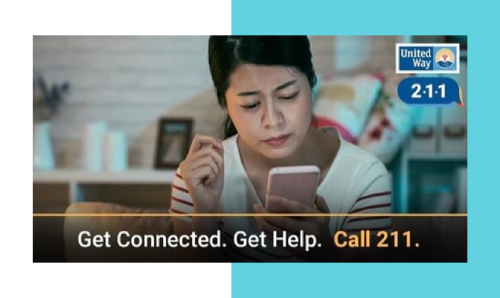Enabling Social Assistance with Technology

Client Success Story:
United Way of Southwestern Pennsylvania

A complex daily challenge
Thousands of people across North America dial, text, or go online to access 2-1-1 for information and referrals to, human services, nonprofit organizations, and other resources every day. The service is free, confidential, and available around the clock. It’s supported by United Way Worldwide and an array of funders and other partners who are committed to developing replicable solutions to complex problems.
2-1-1 is a national brand, not a nationwide infrastructure; it is implemented at the local level by independent United Way affiliates that mobilize the philanthropic community to address an area’s most pressing issues. Consumers can learn about available local program and services by browsing their regional 2-1-1’s database or by interacting with Trained Call Specialists who refer to appropriate services, provide empathetic assistance and, in some cases, follow up with additional support and encouragement.

Complex current systems to deliver hyperlocal services
Building and maintaining a regional database is arduous, and once it’s built it’s hard to change. But that’s just the first challenge, according to Richard LaPratt, 2-1-1 Database and Technology Director at United Way of Southwestern Pennsylvania, which powers PA 2-1-1 Southwest, PA 2-1-1 Northwest, and 2-1-1 SEPA, serving a total of 30 counties across the state.
Each county’s I&R ecosystem has a different set of consumers, providers, and programs which should, ideally, be integrated to streamline access and increase functionality. LaPratt says that all communities have some features in common, but “there’s no single software mold that will fit what each community brings to the table. 2-1-1 is for everyone, but our systems aren’t designed to cater to everyone. The question is how to enhance and market the hyperlocal service you’re providing. How do you intelligently cater to more people, so more people who need your service will use it?” Providing seamless service can be a technological challenge for regional 2-1-1 networks with limited manpower and resources.
Creating an easy to use modular and agile solution

In August 2020, PA 2-1-1 Southwest found partners to confront their technology challenge. LaPratt and Maartje Van Krieken, PA 2-1-1 Southwest Projects Manager, were introduced to Sensez9, a healthcare technology company, through a joint project with Carnegie Mellon University’s Heinz College of Information Systems and Public Policy. “We repurposed our technology during the pandemic to help people get what they needed, when they needed it,” says Jake Gelbort, Business Development Manager at Sensez9. “Our application helped the National Guard in India bring basic needs, like food and medicine, to families stuck at home. This kind of service delivery requires a lot of information sharing across systems, which can be facilitated with simple automation. We saw the same needs in Pennsylvania as in India, so we approached Rich and Maartje to see how we could help.”
Sensez9 showed that its technology could improve PA 2-1-1 Southwest’s efficiency and reach. The system requires a limited investment in infrastructure and is scalable to 2-1-1 systems nationwide. It has the capacity to screen for program eligibility per any specifications, push information directly to provider partners, send confirmations and reminders, and provide useful feedback on who uses 2-1-1 and why. United Way’s early collaboration with Sensez9 has allowed eligible consumers to schedule free income tax preparation appointments at a host of sites operated by area providers, a process that normally entails hiring and training a staff of dedicated 2-1-1 operators. Sensez9 is currently well-positioned to apply the same model to United Way’s transportation partnership with Lyft. Its tool has multiple applications because it sits between systems a 2-1-1 already has; it can be used to streamline information sharing and communication within teams, coordinate volunteer activities, deliver training, or schedule clients for services at venues from homeless shelters to childcare centers. “To put it simply,” says LaPratt, “Sensez9 can take a piece of any database, narrow its focus, and simplify the user experience for consumers. The interface is a self-advocacy tool that lets people select the service they need, schedule it themselves, and complete it. It frees up our Resource Navigators to do the things only they can do.”

Responsive collaboration to deliver impact
Van Krieken, who has extensive international experience in change management and technology, has worked closely with Sensez9 during the collaboration and appreciates how accessible and responsive the company is. “Every time we walked them through our processes, they came back in ways that showed they heard us. They’re completely transparent. They get things done. They don’t make you sit through sales pitches or try to lock you into licenses, and they don’t pretend to know what your world is like,” she says. When Gelbort wanted to understand what was involved in scheduling transportation for clients to and from vaccine sites, for instance, he manned a phone line himself. “They realize that we’re constantly re-ordering our priorities to meet the community’s needs. That we can’t make a major commitment, and that we’re pulled in a lot of different directions. They’ve been a great partner for us.”
LaPratt acknowledges that United Way’s collaboration with Sensez9 was a lucky accident. “We got this because we went out of our comfort zone,” he says. Working with Sensez9 has helped United Way learn, and that will drive the direction it wants to take 2-1-1. “This system gives us feedback about what works for people in our communities. These are the hidden gems that an organization may not see, or utilize to maximum effect, on its own.” Van Krieken agrees. “Integrated referral networks are coming. Without knowing where to start, we’d have a lot of trial and error. So far, our only error is that we’ve been too slow to deploy what Sensez9 has developed for us.” For more information on this program, please reach out to Jake Gelbort at jake@sensez9.tech.




